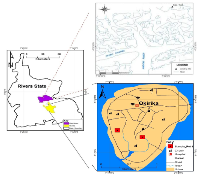Comparison of Microbial, Nutrient and Heavy Metal Contents of Mangrove (Rhyzophora Racemosa) and Nypa Palm (Nypa Fruticans) Roots Collected From Selected Sitesin Rivers State.
Keywords:
Rhizophora species, heavy metals, microbial contents, Nypa palm root, mangrovesAbstract
Mangroves are native species while Nypa palms are foreign species introduced into the Niger Delta. This study is aimed at determining the cause of the rapid encroachment of Nypa palm into mangrove forest. Root and soil samples were collected randomly in mangrove and Nypa palm forests at Asarama and Okrika. Heavy metal, nutrient and microbial analyses were carried out on the root samples. Results show that the bacterial content (4.85 ± 0.6 cfu/g × 106) was more than fungal content (0.35 ± 0.01 cfu/g × 106) in mangrove and Nypa palm roots. Mangrove roots had slightly higher microbial content (2.85 cfu/g × 106) than Nypa palm roots (2.35 cfu/g × 106) while Nypa palm roots had higher heavy metal content (7.7 ± 3.2 mg/kg) than mangrove roots (2.7 ± 1.2 mg/kg). Average nutrient content was more in mangrove roots (123.9 ± 121.1mg/kg) than in Nypa palm roots (44.9 ± 40.7 mg/kg).
Furthermore, physical and microscopic observations indicate that Nypa palm roots were “straw-like” and hollow while the mangrove roots are thick and non-hollow. The morphology of the palm root predisposes them to absorbing more nutrients than mangrove roots. This implies that mangrove roots are slow transmitters of nutrients as compared to Nypa palm roots, which are quick transmitters of nutrient. Nypa palm thus have competitive advantage over mangroves in nutrient utilization despite the presence of heavy metals. These results provide some answers to why the palms are speedily colonizing many mangrove forest areas
in the Niger Delta.
Downloads
References
Alongi, D. M. (2005). Mangrove–microbe–soil relations. Interactions between macro-and microorganisms in marine sediments, 85-103.
E.I.A. (2001). Natural gas liquid export project by the Nigerian Agip Oil Company Limited. Report No. 0096. Pp. 13.
Feller, I. C., Lovelock, C. E., Berger, U., McKee, K. L., Joye, S. B., & Ball, M. C. (2010). Biocomplexity in mangrove ecosystems. Ann. Rev. of
Mar. Sci.2: 395-417.
Kathiresan, K and Bingham, B.L. (2001). Biology of mangroves and mangrove ecosystems. Adv. in Mar. Biol.40: 81-251.
Keay, R.W.J., Onochie, C.F.A. and Standfield, D. P. (1964). Nigerian trees. Federal Department of Forestry Research, National Press Limited, Ibadan, Nigeria.
Alongi, D. M. (2005). Mangrove–microbe–soil relations. Interactions between macro-and microorganisms in marine sediments, 85-103.
E.I.A. (2001). Natural gas liquid export project by the Nigerian Agip Oil Company Limited. Report No. 0096. Pp. 13.
Feller, I. C., Lovelock, C. E., Berger, U., McKee, K. L., Joye, S. B., & Ball, M. C. (2010). Biocomplexity inmangrove ecosystems. Ann. Rev. of Mar. Sci.2: 395-417.
Kathiresan, K and Bingham, B.L. (2001). Biology of mangroves and mangrove ecosystems. Adv. in Mar. Biol.40: 81-251.
Keay, R.W.J., Onochie, C.F.A. and Standfield, D. P. (1964). Nigerian trees. Federal Department of Forestry Research, National Press Limited, Ibadan, Nigeria.

Downloads
Published
Issue
Section
License

This work is licensed under a Creative Commons Attribution-NonCommercial-ShareAlike 4.0 International License.







